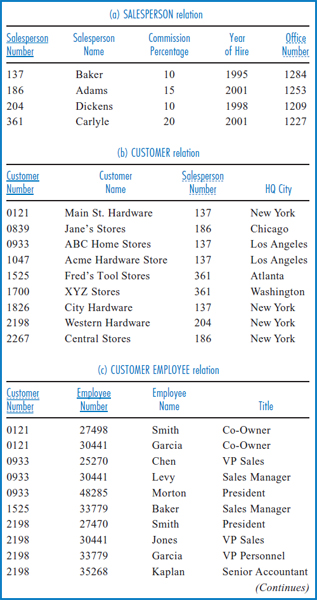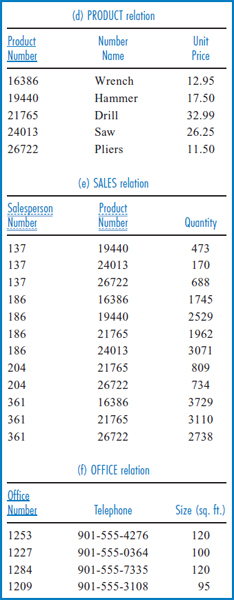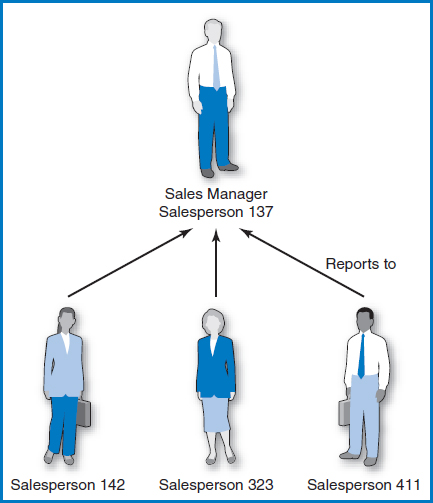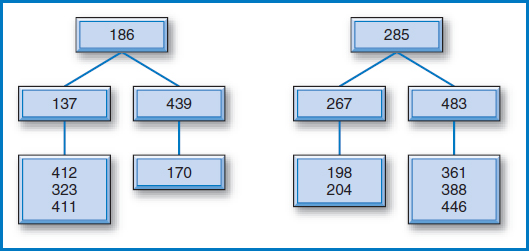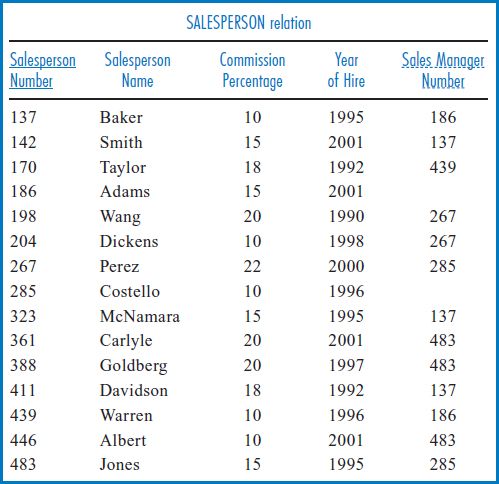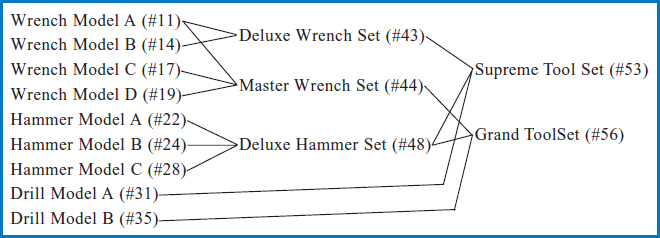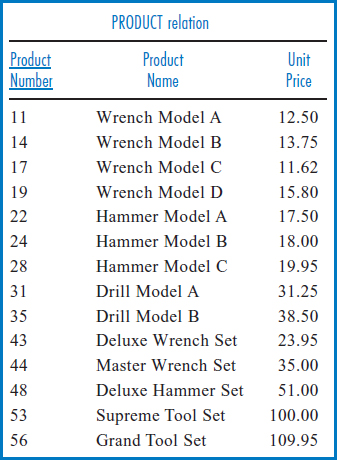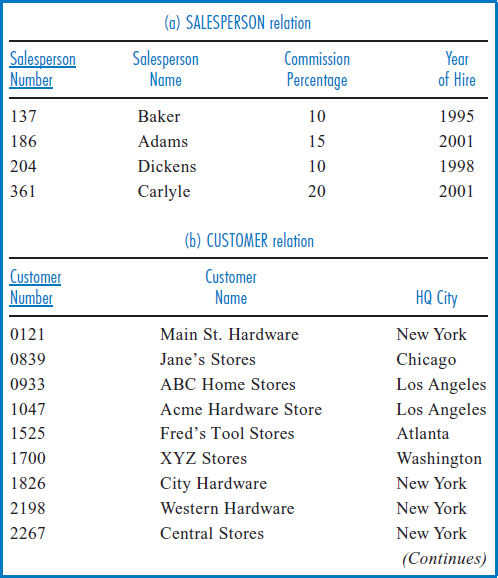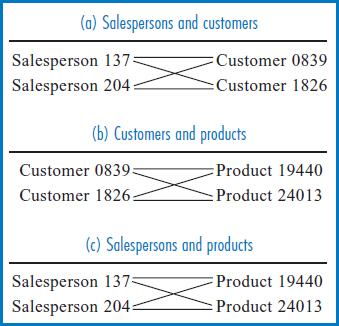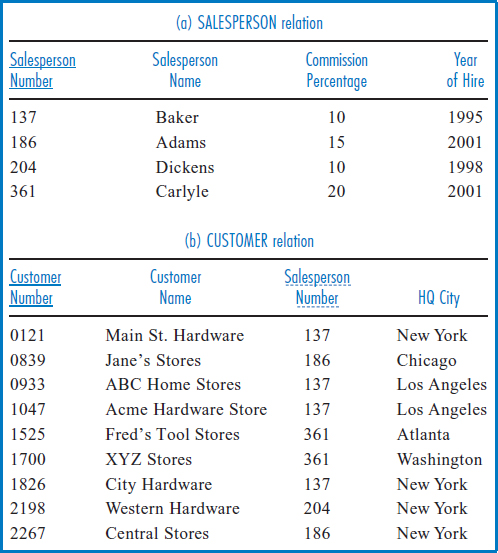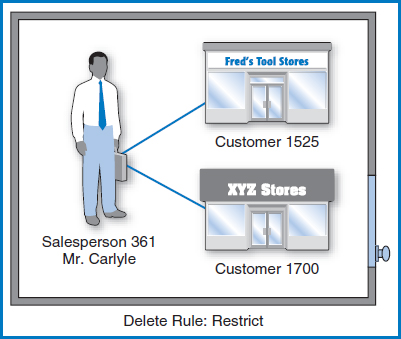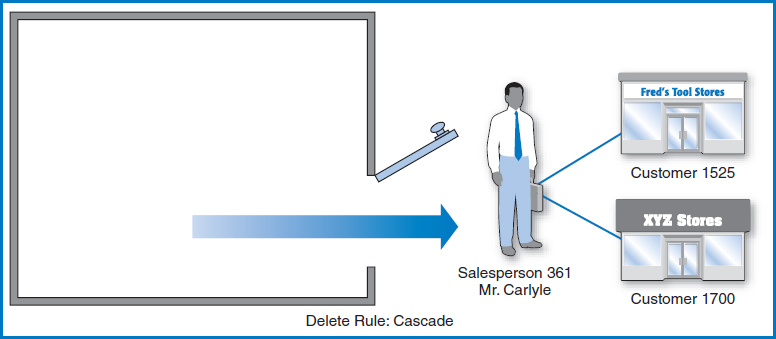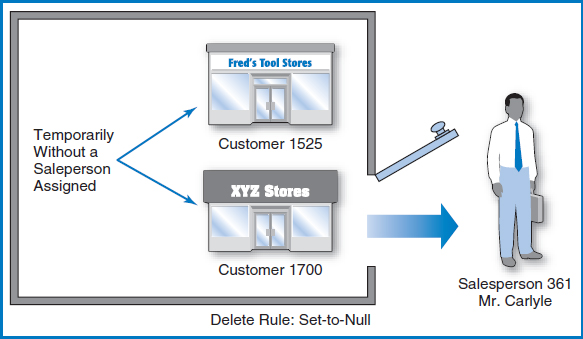CHAPTER 6
THE RELATIONAL DATABASE MODEL: ADDITIONAL CONCEPTS
Chapter 5 defined the basic terminology of relational database and then demonstrated some fundamental ideas about constructing relations in relational databases and manipulating data in them. The discussion focused on relationships between two different entity types, i.e. binary relationships. This chapter will go beyond binary relationships into unary and ternary relationships. It will then address the important issue of referential integrity.
OBJECTIVES
- Describe how unary and ternary relationships are implemented in a relational database.
- Explain the concept of referential integrity.
- Describe how the referential integrity restrict, cascade, and set-to-null delete rules operate in a relational database.
CHAPTER OUTLINE
- Introduction
- Relational Structures for Unary and Ternary Relationships
- Unary One-to-Many Relationships
- Unary Many-to-Many Relationships
- Ternary Relationships
- Referential Integrity
- The Referential Integrity Concept
- Three Delete Rules
- Summary
INTRODUCTION
The previous chapter talked about how binary relationships, i.e. those involving two entity types, can be constructed in relational databases so that the data can be integrated while data redundancy is avoided. Unary relationships, with one entity type, and ternary relationships, with three entity types, while perhaps not quite as common as binary relationships, are also facts of life in the real world and so must also be handled properly in relational databases.
Referential integrity addresses a particular issue that can arise between two tables in a relational database. The issue has to do with a foreign key value in one table being able to find a matching primary key value in another table during a join operation. Interestingly, in the older hierarchical and network database management systems, the equivalents of primary and foreign keys were linked by physical address pointers and so were always tied together. But, in relational databases, the tables are basically independent of each other. So, if there are no controls in place, the proper foreign key-primary key matches can be lost when data is updated or records are deleted.
This chapter will address the issues of unary relationships, ternary relationships, and referential integrity, all of which will move us much closer to modeling real-world business environments properly in relational databases.
CONCEPTS IN ACTION
6-A CITY OF MEMPHIS, TN – VEHICLE SERVICE CENTER
The city of Memphis, TN, is the 18th largest city in the United States in both population (650,000) and land area (280 square miles). Memphis was founded in 1819 by General/President Andrew Jackson and others and was incorporated as a city in 1826. Because of its position on the Mississippi River in the midst of the country's largest cotton-farming region, Memphis has traditionally been the center of the U.S. cotton industry. It is still the world's largest spot-cotton market and also the world's largest hardwood market. The concept of the grocery supermarket was invented in Memphis in the early 1900s and the concept of the motel chain was invented in Memphis in the 1950s. Today, because of its central location in the country and because of its position as a major transportation hub, Memphis is known as the “Distribution Center” of the United States.
The Vehicle Service Center of the Memphis city government's General Services Division is responsible for all of the city's municipal vehicles except for Fire Department vehicles. The approximately 4,000 vehicles include everything from police cruisers and sanitation trucks to street cleaners and even lawn-mowing tractors. Since 1991, the city has kept track of all these vehicles with a database application that manages them through their complete lifecycle. New vehicles are entered into the database when they are purchased and they're assigned to a city department. The application then keeps each vehicle's maintenance history, generates automatic reports on maintenance due dates, tracks mileage and gasoline use, and produces monthly reports for the departments listing all of this activity for each of their vehicles. Finally, the system tracks the reassignment of older vehicles and the auctioning of vehicles being disposed of.
Memphis' vehicle tracking system uses an Oracle database running on Dell servers. For vehicle maintenance, the system's major tables include a Vehicle Downtime Detail table with 1.6 million records, a Work Order Job Notes table with 3.3 million records, and a Parts Journal table with 950,000 records.
“Photo by Permission of City of Memphis”
RELATIONAL STRUCTURES FOR UNARY AND TERNARY RELATIONSHIPS
Unary One-to-Many Relationships
Let's continue with the General Hardware Co. example of Figure 5.14, reprinted here for convenience as Figure 6.1. Suppose that General Hardware's salespersons are organized in such a way that some of the salespersons, in addition to having their customer responsibilities, serve as the sales managers of other salespersons, Figure 6.2. A salesperson reports to exactly one sales manager, but each salesperson who serves as a sales manager typically has several salespersons reporting to him. Thus, there is a one-to-many relationship within the set or entity type of salespersons.
![]()
This is known as a unary one-to-many relationship. It is unary because there is only one entity type involved. It is one-to-many because among the individual entity occurrences, i.e. among the salespersons, a particular salesperson reports to one salesperson who is his sales manager while a salesperson who is a sales manager may have several salespersons reporting to her. Note that, in general, this arrangement can involve as few as two levels of entity occurrences or can involve many levels in a hierarchical arrangement. In general, in a company, an employee can report to a manager who in turn reports to a higher-level manager, and so on up to the CEO.
FIGURE 6.1 General Hardware Company relational database
Assume that the General Hardware Co. has two levels of sales managers, resulting in a three-level hierarchy. That is, each salesperson reports to a sales manager (who is himself a salesperson) and each sales manager reports to one of several chief sales managers (who is herself a salesperson). Figure 6.3 shows two levels of sales managers plus the salespersons who report to them. For example, salespersons 142, 323, and 411 all report to salesperson (and sales manager) 137. Salespersons 137 and 439, both of whom are sales managers, report to salesperson 186 who is a chief sales manager. As you go upward in the hierarchy, each salesperson is associated with exactly one other salesperson. As you go downward in the hierarchy from any salesperson/sales manager, each salesperson/sales manager is associated with many salespersons below, except for the bottom-level salespersons who are not sales managers and thus have no one reporting to them.
FIGURE 6.2 Salespersons 142, 323, and 411 reporting to salesperson 137 who is their sales manager
FIGURE 6.3 General Hardware Company salesperson reporting hierarchy
Figure 6.4, which is an expansion of the General Hardware Co. SALESPERSON relation in Figure 6.1a, demonstrates how this type of relationship is reflected in a relational database. A one-to-many unary relationship requires the addition of one column to the relation that represents the single entity involved in the unary relationship. In Figure 6.4, the Sales Manager Number attribute is the new attribute that has been added to the SALESPERSON relation. The domain of values of the new column is the same as the domain of values of the relation's primary key. Thus, the values in the new Sales Manager Number column will be three-digit whole numbers representing the unique identifiers for salespersons, just like the values in the Salesperson Number column. The value in the new column for a particular row represents the value of the next entity “upward” in the unary one-to-many hierarchy. For example, in the row for salesperson number 323, the sales manager value is 137 because salesperson 323's sales manager is salesperson/sales manager 137, as shown in Figure 6.3. Similarly, the row for salesperson 137, who happens also to be a sales manager, shows salesperson number 186 in its sales manager number column. Salesperson/sales manager 137 reports to chief sales manager 186, also as shown in Figure 6.3. The sales manager column value for salesperson/chief sales manager 186 is blank because the reporting structure happens to end with each chief sales manager; i.e., there is nothing “above” salesperson 186 in Figure 6.3.
FIGURE 6.4 General Hardware Company SALESPERSON relation including Sales Manager Number attribute
Note that a unary one-to-one relationship, for example one salesperson backing-up another (see Figure 2.7a) is handled in a manner similar to Figure 6.4. The difference is that the Sales Manager Number column would be replaced by a Back-Up Number column and a particular salesperson number would appear at most once in that column.
Unary Many-to-Many Relationships
The unary many-to-many relationship is a special case that has come to be known as the “bill of materials” problem. Among the entity occurrences of a single entity type, which is what makes this “unary,” each particular entity occurrence can be related to many other occurrences and each of those latter occurrences can, in turn, be related to many other occurrences. Put another way, every entity occurrence can be related to many other occurrences, which, if you think about it, makes this a many-to-many relationship because only one entity type is involved. (Yes, that sounds a little strange, but keep reading.) The general idea is that in a complex item, say an automobile engine, small parts are assembled together to make a small component or assembly. Then some of those small components or assemblies (and maybe some small parts) are assembled together to make medium-sized components or assemblies, and so on until the final, top-level “component” is the automobile engine. The key concept here is that an assembly at any level is considered to be both a part made up of smaller units and a unit that can be a component of a larger part. Parts and assemblies at all levels are all considered occurrences of the same entity type and they all have a unique identifier in a single domain of values.
FIGURE 6.5 General Hardware Company product bill of materials
Certainly, this requires an example! Figure 6.5 illustrates this concept using an expansion of General Hardware Co.'s product set.
![]()
The numbers in parentheses are product numbers. Assume, as is quite reasonable, that General Hardware not only sells individual tools but also sells sets of tools. Both individual tools and sets of tools are considered to be “products,” which also makes sense. As shown in Figure 6.5, General Hardware carries several types (or perhaps sizes) of wrenches, hammers, and drills. Various combinations of wrenches and hammers are sold as wrench and hammer sets. Various combinations of these sets and other tools such as drills are sold as even larger sets. Very importantly, notice the many-to-many nature of this arrangement. For example, the Master Wrench Set (product number 44), looking to its left, is comprised of three different wrenches, including Wrench Model A (#11). Conversely, Wrench Model A, looking to its right, is a component of two different wrench sets, both the Deluxe Wrench Set (#43) and the Master Wrench Set (#44). This demonstrates the many-to-many nature of products. Similarly, both the Supreme Tool Set (#53) and the Grand Tool Set (#56) are, obviously, comprised of several smaller sets and tools, while the Deluxe Hammer Set (#48) is a component of both the Supreme Tool Set (#53) and the Grand Tool Set (#56).
How can this unary many-to-many relationship be represented in a relational database? First of all, note that Figure 6.6 is a modification and expansion of the PRODUCT relation in the General Hardware Co. relational database of Figure 6.1d. Note that the product numbers matching the product numbers in Figure 6.5 have been reduced to two digits for simplicity in the explanation. Every individual unit item and every set in Figure 6.5 has its own row in the relation in Figure 6.6 because every item and set in Figure 6.5 is a product that General Hardware has for sale.
Now, here is the main point. Just as a binary many-to-many relationship requires the creation of an additional relation in a relational database, so does a unary many-to-many relationship. The new additional relation is shown in Figure 6.7. It consists of two attributes. The domain of values of each column is that of the Product Number column in the PRODUCT relation of Figure 6.6. The relation of Figure 6.7 represents, in a tabular format, the way that the assemblies of Figure 6.5 are constructed. The first two rows of Figure 6.7 literally say that product (assembly) number 43 (the Deluxe Wrench Set) is comprised of products 11 and 14, as indicated in Figure 6.5. Next, product (assembly) 44 is comprised of products 11, 17, and 19. Moving to the last three rows of the relation, product (assembly) 56 is comprised of products 44 and 48, both of which happen to be assemblies, and product 35. Again, notice the many-to-many relationship as it is represented in the relation of Figure 6.7. The first two rows indicate that assembly 43 is comprised of two parts. Conversely, the first and third rows indicate that part 11 is a component of two different assemblies.
FIGURE 6.6 General Hardware Company modified PRODUCT relation
FIGURE 6.7 General Hardware Company unary many-to-many relation
Ternary Relationships
A ternary relationship is a relationship that involves three different entity types. If the entity types are A, B, and C, then we might illustrate this as:
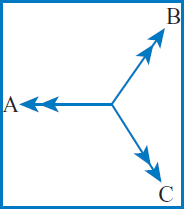
To demonstrate this concept in the broadest way using the General Hardware Co. database, let's slightly modify part of the General Hardware premise. The assumption has always been that there is a one-to-many relationship between salespersons and customers. A salesperson is responsible for several customers, while a customer is in contact with (is sold to by) exactly one of General Hardware's salespersons. For the purposes of describing a general ternary relationship, we change that premise temporarily to a many-to-many relationship between salespersons and customers. That is, we now assume that any salesperson can make a sale to any customer and any customer can buy from any salesperson.
With that change, consider the ternary relationship among salespersons, customers, and products. Such a relationship allows us to keep track of which salesperson sold which product to which customer. This is very significant. In this environment, a salesperson can sell many products and a salesperson can sell to many customers. A product can be sold by many salespersons and can be sold to many customers. A customer can buy many products and can buy from many salespersons. All of this leads to a lot of different possibilities for any given sale. So, it is very important to be able to tie down a particular sale by noting and recording which salesperson sold which product to which customer. For example, we might store the fact that salesperson 137 sold some of product number 24013 to customer 0839, Figure 6.8.
Relations a, b, and c of Figure 6.9 show the SALESPERSON, CUSTOMER, and PRODUCT relations, respectively, from the General Hardware relational database of Figure 6.1, except for one change. Since there is no longer a one-to-many relationship between salespersons and customers, the Salesperson Number foreign key in the CUSTOMER relation has been removed! The three relations are now all quite independent with no foreign keys in any of them.
Figure 6.9d, the SALES relation, shows how this ternary relationship is represented in a relational database. Similarly to how we created an additional relation to accommodate a binary many-to-many relationship, an additional relation has to be created to accommodate a ternary relationship, and that relation is Figure 6.9d. Clearly, as in the binary many-to-many case, the primary key of the additional relation will be (at least) the combination of the primary keys of the entities involved in the relationship. Thus, in Figure 6.9d, the Salesperson Number, Customer Number, and Product Number attributes all appear as foreign keys and the combination of the three serve as part of the primary key. Why just “part of” the primary key? Because in this example, a particular salesperson may have sold a particular product to a particular customer more than once on different dates. Thus the Date attribute must also be part of the primary key. (We assume that this combination of the three could not have happened more than once on the same date. If it could, then there would also need to be a “time” attribute in the key.) Recall that this need for an additional attribute in the primary key also came up when we discussed binary many-to-many relationships in the last chapter. Finally, the Quantity attribute in Figure 6.9d is intersection data, just as it would be in a binary many-to-many relationship. The quantity of the product that the salesperson sold to the customer is clearly an attribute of the ternary relationship, not of any one of the entities.
FIGURE 6.8 A ternary relationship
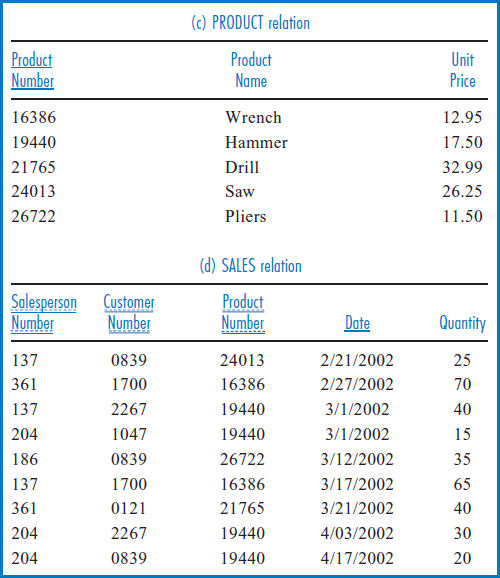
FIGURE 6.9 A portion of General Hardware Company relational database modified to demonstrate a ternary relationship
There is one more important point to make about ternary relationships. In the process of describing the ternary relationship, you may have noticed that, taken two at a time, every pair of the three entities, salespersons, customers, and products, are in a binary many-to-many relationship. In general, this would be shown as:

The question is: are these three many-to-many relationships the equivalent of the ternary relationship? Do they provide the same information that the ternary relationship does? The answer is, no!
FIGURE 6.10 Ternary relationship counter-example
Again, consider salespersons, customers, and products. You might know that a particular salesperson has made sales to a particular customer. You might also know that a particular salesperson has sold certain products at one time or another. And, you might know that a particular customer has bought certain products. But all of that is not the same thing as knowing that a particular salesperson sold a particular product to a particular customer. Still skeptical? Look at Figure 6.10. Parts a, b, and c of the figure clearly illustrate three many-to-many relationships. They are between (a) salespersons and customers, (b) customers and products, and (c) salespersons and products. Part a shows, among other things, that salesperson 137 sold something to customer 0839. Part b shows that customer 0839 bought product 19440. Does that mean that we can infer that salesperson 137 sold product 19440 to customer 0839? No! That's a possibility and, indeed, part c of the figure shows that salesperson 137 did sell product 19440. But part c of the figure also shows that salesperson 204 sold product 19440. Is it possible that salesperson 204 sold it to customer 0839? According to part a, salesperson 204 sold something to customer 0839, but it doesn't indicate what. You can go around and around Figure 6.10 and never conclude with certainty that salesperson 137 sold product 19440 to customer 0839. That would require a ternary relationship and a relation like the one in Figure 6.9d. Notice that the last row of Figure 6.9d shows, without a doubt, that it was salesperson 204 who sold product 19440 to customer 0839.
YOUR TURN
6.1 TERNARY RELATIONSHIPS
Ternary relationships are all around us. Think about an automobile dealership. Certainly the dealership management wants to keep track of which car was sold to which customer by which salesperson. Certainly this is important for billing, accounting, and commission purposes. But also, in that kind of high-priced product environment, it's simply good business to keep track of such information for future marketing and customer relationship reasons.
QUESTION:
Consider a hospital environment involving patients, doctors, nurses, procedures, medicines, hospital rooms, etc. Make a list of five ternary relationships in this environment. Remember that each one has to make sense from a business point of view.
REFERENTIAL INTEGRITY
The Referential Integrity Concept
Thus far in this chapter and the previous one, we have been concerned with how relations are constructed and how data can be retrieved from them. Data retrieval is the operation that clearly provides the ultimate benefit from maintaining a database, but it is not the only operation needed. Certainly, we should expect that, as with any data storage scheme, in addition to retrieving data we must be prepared to perform such data maintenance operations as inserting new records (or rows of a relation), deleting existing records, and updating existing records. All database management systems provide the facilities and commands to accomplish these data maintenance operations. But there are some potential pitfalls in these operations that must be dealt with.
The problem is that the logically related (by foreign keys) but physically independent nature of the relations in a relational database exposes the database to the possibility of a particular type of data integrity problem. This problem has come to be known as a referential integrity problem because it revolves around the circumstance of trying to refer to data in one relation in the database, based on values in another relation. (Actually, referential integrity is an issue in all of the DBMS approaches, not just the relational approach. We discuss this issue here because we are focusing on relational databases and the concept is much easier to explain in the context of an example, again the General Hardware database.) Also, while referential integrity problems can surface in any of the three operations that result in changes to the database—insert, delete, and update records—we will generally use the case of delete to explain the concept while mentioning insert and update where appropriate.
First, consider the situation of record deletion in the two relations of Figure 6.11, which is a repeat of Figure 5.2. Suppose that salesperson 361, Carlyle, left the company and his record was deleted from the SALESPERSON relation. The problem is that there are still two records in the CUSTOMER relation (the records for customers 1525 and 1700) that refer to salesperson 361, i.e. that have the value 361 in the Salesperson Number foreign key attribute. It is as if Carlyle left the company and his customers have not as yet been reassigned to other salespersons. If a relational join command was issued to join the two relations in order to (say) find the name of the salesperson responsible for customer 1525, there would be a problem. The relational DBMS would pick up the salesperson number value 361 in the record for customer 1525 in the CUSTOMER relation, but would not be able to match 361 to a record in the SALESPERSON relation because there no longer is a record for salesperson 361 in the SALESPERSON relation—it was deleted! Notice that the problem arose because the deleted record, a salesperson record, was on the “one side” of a one-to-many relationship. What about the customer records on the “many side” of the one-to-many relationship? Suppose customer 1047, Acme Hardware Store, is no longer one of General Hardware's customers. Deleting the record for customer 1047 in the CUSTOMER relation has no referential integrity exposure. Nothing else in these two relations refers to customer 1047.
FIGURE 6.11 General Hardware Company SALESPERSON and CUSTOMER relations
Similar referential integrity arguments can be made for the record insertion and update operations, but the issue of whether the exposure is on the “one side” or the “many side” of the one-to-many relationship changes! Again, in the case of deletion, the problem occurred when a record was deleted on the “one side” of the one-to-many relationship. But, for insertion, if a new salesperson record is inserted into the Salesperson relation, i.e. a new record is inserted into the “one side” of the one-to-many relationship, there is no problem. All it means is that a new salesperson has joined the company but, as yet, has no customer responsibility. On the other hand, if a new customer record is inserted into the CUSTOMER relation, i.e. a new record is inserted into the “many side” of the one-to-many relationship, and it happens to include a salesperson number that does not have a match in the SALESPERSON relation, that would cause the same kind of problem as the deletion example above. Similarly, the update issue would concern updating a foreign key value, i.e. a salesperson number in the CUSTOMER relation with a new salesperson number that has no match in the SALESPERSON relation.
The early relational DBMSs did not provide any control mechanisms for referential integrity. Programmers and users were on their own to keep track of it and this upset many people. This was particularly the case because referential integrity issues in the older hierarchical and network DBMSs were more naturally controlled by the nature of the hierarchical and network data structures on which they were based, at the expense of some flexibility in database design. Modern relational DBMS's provide sophisticated control mechanisms for referential integrity with so-called “delete rules,” “insert rules,” and “update rules.” These rules are specified between pairs of relations. We will take a look at the three most common delete rules, “restrict,” “cascade,” and “set-to-null,” to illustrate the problem.
FIGURE 6.12 Delete rule: Restrict
Three Delete Rules
Delete Rule: Restrict Again, consider the two relations in Figure 6.11. If the delete rule between the two relations is restrict and an attempt is made to delete a record on the “one side” of the one-to-many relationship, the system will forbid the delete to take place if there are any matching foreign key values in the relation on the “many side.” For example, if an attempt is made to delete the record for salesperson 361 in the SALESPERSON relation, the system will not permit the deletion to take place because the CUSTOMER relation records for customers 1525 and 1700 include salesperson number 361 as a foreign key value, Figure 6.12. This is as if to say, “You can't delete a salesperson record as long as there are customers for whom that salesperson is responsible.” Clearly, this is a reasonable and necessary course of action in many business situations.
Delete Rule: Cascade If the delete rule between the two relations is cascade and an attempt is made to delete a record on the “one side” of the relationship, not only will that record be deleted but all of the records on the “many side” of the relationship that have a matching foreign key value will also be deleted. That is, the deletion will cascade from one relation to the other. For example, if an attempt is made to delete the record for salesperson 361 in the SALESPERSON relation and the delete rule is cascade, that salesperson record will be deleted and so too, automatically, will the records for customers 1525 and 1700 in the CUSTOMER relation because they have 361 as a foreign key value, Figure 6.13. It is as if the assumption is that when a salesperson leaves the company she always takes all of her customers along with her. While that might be a bit of a stretch in this case, there are many other business situations where it is not a stretch at all. For example, think about a company that has a main employee relation with name, home address, telephone number, etc., plus a second relation that lists and describes the several skills of each employee. Certainly, when an employee leaves the company you would expect to delete both his record in the main employee relation and all his records in the skills relation.
Delete Rule: Set-to-Null If the delete rule between the two relations is set-to-null and an attempt is made to delete a record on the “one side” of the one-to-many relationship, that record will be deleted and the matching foreign key values in the records on the “many side” of the relationship will be changed to null. For example, if an attempt is made to delete the record for salesperson 361 in the SALESPERSON relation, that record will be deleted, and the Salesperson Number attribute values in the records for customers 1525 and 1700 in the CUSTOMER relation will be changed from 361 to null, Figure 6.14. This is as if to say, “You can delete a salesperson record and, we will indicate that, temporarily at least, their former customers are without a salesperson.” Obviously this is the appropriate response in many business situations.
FIGURE 6.13 Delete rule: Cascade
FIGURE 6.14 Delete rule: Set-to-Null
SUMMARY
Relational databases must be capable of handling unary and ternary relationships, as well as binary relationships. All of these have to promote data integration while avoiding data redundancy. As this chapter demonstrated, the relational database concept is up to this task.
Referential integrity is an important issue in relational databases. Relational database management systems must be able to allow users to specify referential integrity controls between related tables. Otherwise, changes to one table that are not coordinated with a related table may cause serious data integrity problems.
KEY TERMS
Cascade delete rule
Delete rules
Entity occurrence
Insert rules
Record deletion
Referential integrity
Restrict delete rule
Set-to-null delete rule
Update rules
QUESTIONS
- Describe the concept of the unary one-to-many relationship.
- How is a unary one-to-many relationship constructed in a relational database?
- Describe the concept of the unary many-to-many relationship.
- How is a unary many-to-many relationship constructed in a relational database?
- Describe the concept of the ternary relationship.
- How is a ternary relationship constructed in a relational database?
- Is a ternary relationship the equivalent of the three possible binary relationships among the three entities involved? Explain.
- Describe the problem of referential integrity.
- Compare and contrast the three delete rules: restrict, cascade, and set-to-null.
EXERCISES
- Leslie's Auto Sales has a relational database with which it maintains data on its salespersons, its customers, and the automobiles it sells. Each of these three entity types has a unique attribute identifier. The attributes that it stores are as follows:
- Salesperson Number (unique), Salesperson Name, Salesperson Telephone, Years with Company
- Customer Number (unique), Customer Name, Customer Address, Value of Last Purchase From Us
- Vehicle Identification Number (unique), Manufacturer, Model, Year, Sticker Price Leslie's also wants to keep track of which salesperson sold which car to which customer, including the date of the sale and the negotiated price. Construct a relational database for Leslie's Auto Sales.
- The State of New York certifies firefighters throughout the state and must keep track of all of them, as well as of the state's fire departments. Each fire department has a unique department number, a name that also identifies its locale (city, county, etc.), the year it was established, and its main telephone number. Each certified firefighter has a unique firefighter number, a name, year of certification, home telephone number, and a rank (firefighter, fire lieutenant, fire captain, etc.) The state wants to record the fire department for which each firefighter currently works and each firefighter's supervisor. Supervisors are always higher-ranking certified firefighters. Construct a relational database for New York's fire departments and firefighters.
- The ABC Consulting Corp. contracts for projects that, depending on their size and skill requirements, can be assigned to an individual consultant or to a team of consultants. A consultant or a team can work on several projects simultaneously. Several employees can be organized into a team. Larger teams can consist of a combination of smaller teams, sometimes with additional individual consultants added. This pattern can continue to larger and larger teams. ABC wants to keep track of its consultants, teams, and projects, including which consultant or team is responsible for each project. Each consultant has a unique employee number, plus a name, home address, and telephone number. Each project has a unique project number, plus a name, budgeted cost, and due date. Construct a relational database for ABC Consulting. Hint: You may want to develop an attribute called “responsible party” that can be either a team or an individual consultant. Each project has one responsible party that is responsible for its completion. Or you may want to think of an individual consultant as a potential “team of one” and have the responsibility for each project assigned to a “team” that could then be an individual consultant or a genuine team.
- Consider the General Hardware Corp. database of Figure 6.1. Describe the problem of referential integrity in terms of the CUSTOMER and CUSTOMER EMPLOYEE relations if the record for customer 2198 in the CUSTOMER relation is deleted. (Assume that no delete rules exist.)
- In the General Hardware Corp. database of Figure 6.1, what would happen if:
- The delete rule between the CUSTOMER and CUSTOMER EMPLOYEE relations is restrict and an attempt is made to delete the record for customer 2198 in the CUSTOMER relation?
- The delete rule between the CUSTOMER and CUSTOMER EMPLOYEE relations is cascade and an attempt is made to delete the record for customer 2198 in the CUSTOMER relation?
- The delete rule between the CUSTOMER and CUSTOMER EMPLOYEE relations is set-to-null and an attempt is made to delete the record for customer 2198 in the CUSTOMER relation?
- The delete rule between the CUSTOMER and CUSTOMER EMPLOYEE relations is restrict and an attempt is made to delete the record for employee 33779 of customer 2198 in the CUSTOMER EMPLOYEE relation?
- The delete rule between the CUSTOMER and CUSTOMER EMPLOYEE relations is cascade and an attempt is made to delete the record for employee 33779 of customer 2198 in the CUSTOMER EMPLOYEE relation?
- The delete rule between the CUSTOMER and CUSTOMER EMPLOYEE relations is set-to-null and an attempt is made to delete the record for employee 33779 of customer 2198 in the CUSTOMER EMPLOYEE relation?
MINICASES
- Happy Cruise Lines
- Look at the Happy Cruise Lines database of Chapter 5, Minicase 1 but, for this question, consider only the SHIP, PORT, and PASSENGER relations. The company wants to keep track of which passengers visited which ports on which ships on which dates. Reconstruct these three relations as necessary and/or add additional relation(s) as necessary to store this information.
- Consider the following data from the SHIP and CRUISE relations of the Happy Cruise Lines database of Chapter 5, Minicase 1 :
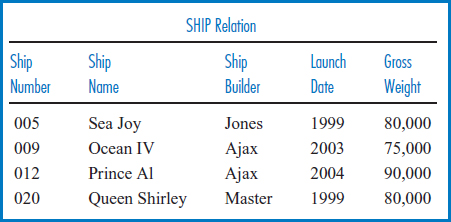
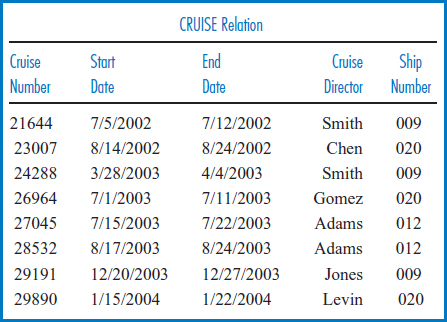
What would happen if:
- The delete rule between the SHIP and CRUISE relations is restrict and an attempt is made to delete the record for ship number 012 in the SHIP relation?
- The delete rule between the SHIP and CRUISE relations is restrict and an attempt is made to delete the record for ship number 005 in the SHIP relation?
- The delete rule between the SHIP and CRUISE relations is cascade and an attempt is made to delete the record for ship number 012 in the SHIP relation?
- The delete rule between the SHIP and CRUISE relations is cascade and an attempt is made to delete the record for ship number 005 in the SHIP relation?
- The delete rule between the SHIP and CRUISE relations is set-to-null and an attempt is made to delete the record for ship number 012 in the SHIP relation?
- The delete rule between the SHIP and CRUISE relations is set-to-null and an attempt is made to delete the record for ship number 005 in the SHIP relation?
- The delete rule between the SHIP and CRUISE relations is restrict and an attempt is made to delete the record for cruise number 26964 in the CRUISE relation?
- The delete rule between the SHIP and CRUISE relations is cascade and an attempt is made to delete the record for cruise number 26964 in the CRUISE relation?
- The delete rule between the SHIP and CRUISE relations is set-to-null and an attempt is made to delete the record for cruise number 26964 in the CRUISE relation?
- Super Baseball League
- In the Super Baseball League database of Chapter 5, Minicase 2, assume that instead of having coaches who are different from players, now some of the players serve as coaches to other players. A player/coach can have several players whom he coaches. Each player is coached by only one player/coach. Reconstruct the database structure to reflect this change.
- In the Super Baseball League database of Chapter 5, Minicase 2, assume that the TEAM relation has a record for team number 17 and that the COACH relation has records for three coaches on that team.
What would happen if:
- The delete rule between the TEAM and COACH relations is restrict and an attempt is made to delete the record for team 17 in the TEAM relation?
- The delete rule between the TEAM and COACH relations is cascade and an attempt is made to delete the record for team 17 in the TEAM relation?
- The delete rule between the TEAM and COACH relations is set-to-null and an attempt is made to delete the record for team 17 in the TEAM relation?
- The delete rule between the TEAM and COACH relations is restrict and an attempt is made to delete the record for one of team 17's coaches in the COACH relation?
- The delete rule between the TEAM and COACH relations is cascade and an attempt is made to delete the record for one of team 17's coaches in the COACH relation?
- The delete rule between the TEAM and COACH relations is set-to-null and an attempt is made to delete the record for one of team 17's coaches in the COACH relation?


